
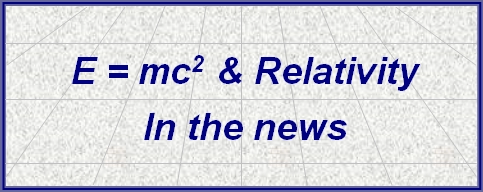
Reports and comment on stories making the news about E = mc
2
, relativity and physics in general.

Liquid helium at near absolute zero
climbing up and out of a container.
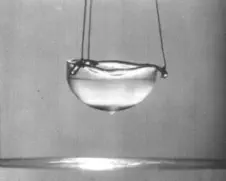
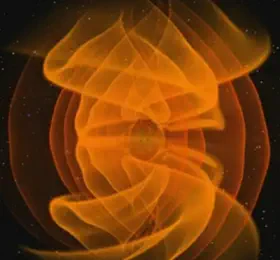
Two black holes (at the centre of the picture)
colliding and merging, and causing ripples in
space-time as they do so.
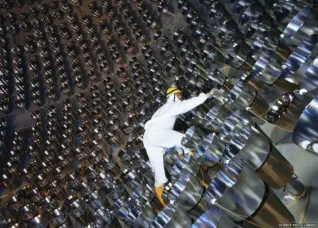
Five new particles discovered (Mar 2017)
Scientists at the Large Hadron Collider have confirmed the existence of
five new subatomic particles, all variants of, or “excited states” of, the
Omega-c baryon, which was itself confirmed in 1994 and is part of the
same family of particles as the more familiar protons and neutrons.
The discovery is important in the understanding of the nuclear strong
force which binds protons and neutrons at the atomic nucleus, as well as
shedding light on how quarks, the building blocks of such particles, bind
together.
The existence of the new particles had been suspected for some time, but
the extraordinary sensitivity of the instruments at the LHC made detection
and confirmation possible.
Full story here: LHCb Particle Discovery
Strange matter wins Nobel physics prize (Oct 2016)
Three British-born scientists have been jointly awarded the 2016 Nobel Prize for Physics for their work on exotic forms of matter. Using mathematical models the three researchers described matter in unusual states, such as those found in superconductors and superfluids, in which matter is cooled to very near absolute zero. Once this is done the matter exhibits strange behaviour, such as never losing electrical energy due to resistance, and counter-intuitive behaviour in which fluids can flow up hill. The discoveries are already being employed in research into a new generation of super-fast computers using quantum computation, such as the Microsoft Q project. Full story here: Nobel Prize and Strange Matter Gravitational waves from black holes discovered (Feb 2016) Scientists working with the Laser Interferometer Gravitational-Wave Observatory (Ligo) have announced the observation of gravitational waves, resulting from the collision and merging of two black holes, each with around 30 times the mass of the Sun. These are the first observations of gravity waves following many years of searching and steady improvements to the detection equipment. If confirmed, as seems likely, it opens up a new way of observing the Universe and will almost certainly change our understanding as much as when the first optical telescopes were pointed to the sky around 400 years ago. And, as with the first optical, radio, infra-red and other telescopes, with the ability to detect gravity waves questions won’t just be answered and theories tested, but new questions will arise that haven’t even been thought of yet, and discoveries made of new objects and phenomena that weren’t even suspected. It really is a major step forward in astronomy. The discovery also offers further and stunning evidence for Einstein’s Theory of Relativity, whose equations first predicted gravity ripples 100 years ago. Full story here: Gravity waves detected First picture of a black hole’s event horizon in 2017 (Jan 2016) Preparations are being made to take the first ever “picture” of a black hole’s event horizon, that of Sagittarius A*, using a network of radio telescopes in 2017. Sagittarius A* is a supermassive black hole at the centre of the Milky Way, around 26,000 light years from Earth, and has a diameter 17 times larger than the Sun. The object is so massive that it bends space-time around itself many millions of times more than our home star does, greatly warping the path of light around it as it does so. The observations will focus on the movement of gas spinning around the black hole allowing its speed to be measured using the Doppler effect. Full story here: Event horizon snapshot due in 2017 Nobel Prize for Neutrino Flip (Oct 2015) Neutrinos are some of the strangest particles in the universe. Produced in stars, including our own Sun, they are almost mass-less and are only outnumbered by photons. They are so small and so numerous that around 65 billion pass through each square centimetre of the Earth and everything on it every second. In the time it takes to read this sentence many hundreds of billions of them will have passed right through you, even if you are on the night side of the Earth. Few, if any, will have interacted with the matter in your body. The discovery that neutrinos can flip between one “flavour” and another is a major breakthrough in understanding particle physics and is another step towards understanding the star at the centre of our solar system. Full story here: Neutrino 'flip' wins physics Nobel Prize Gravitational wave detector switched on (Sept 2015) Gravitational waves are ripples in space-time, first predicted in 1916 by Albert Einstein, and are the result of masses accelerating and so distorting the fabric of space around them. The waves travel at the speed of light but are extremely weak (this is true of gravity in general, which is by far the weakest of the four forces). So far there has been no direct evidence of their existence but indirect evidence comes from a number of sources such as binary star systems and black holes. The goal is to be able to detect direct evidence for gravitational waves, and the latest iteration of the Laser Interferometer Gravitational-Wave Observatory (LIGO) has just come on-stream to try to do just that. Full story here: Advanced Ligo: Labs 'open their ears' to the cosmos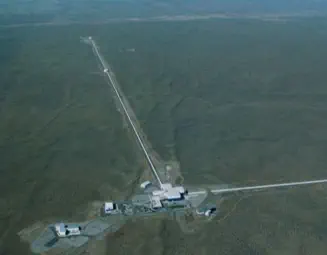
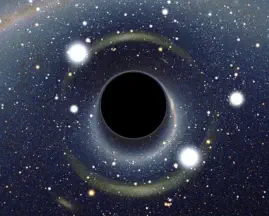
Artist’s impression of gas around a black hole
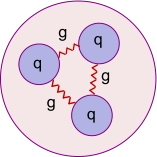
Baryons are made of quarks (q) and
gluons (g), and make up most of the
visible matter in the universe.
Advertisement

In the news
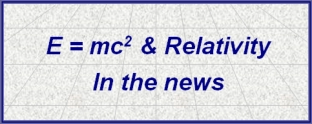
Reports and comment on stories making the news about E =
mc
2
, relativity and physics in general.


Liquid helium at near absolute zero
climbing up and out of a container.
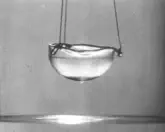
Five new particles discovered (Mar 2017)
Scientists at the Large Hadron Collider have confirmed the
existence of five new subatomic particles, all variants of, or
“excited states” of, the Omega-c baryon, which was itself
confirmed in 1994 and is part of the same family of particles
as the more familiar protons and neutrons.
The discovery is important in the understanding of the
nuclear strong force which binds protons and neutrons at the
atomic nucleus, as well as shedding light on how quarks, the
building blocks of such particles, bind together.
The existence of the new particles had been suspected for
some time, but the extraordinary sensitivity of the
instruments at the LHC made detection and confirmation
possible.
Full story here: LHCb Particle Discovery
Strange matter wins Nobel physics prize (Oct 2016)
Three British-born scientists have been jointly awarded the 2016 Nobel Prize for Physics for their work on exotic forms of matter. Using mathematical models the three researchers described matter in unusual states, such as those found in superconductors and superfluids, in which matter is cooled to very near absolute zero. Once this is done the matter exhibits strange behaviour, such as never losing electrical energy due to resistance, and counter-intuitive behaviour in which fluids can flow up hill. The discoveries are already being employed in research into a new generation of super-fast computers using quantum computation, such as the Microsoft Q project. Full story here: Nobel Prize and Strange Matter Gravitational waves from black holes discovered (Feb 16) Scientists working with the Laser Interferometer Gravitational-Wave Observatory (Ligo) have announced the observation of gravitational waves, resulting from the collision and merging of two black holes, each with around 30 times the mass of the Sun. These are the first observations of gravity waves following many years of searching and steady improvements to the detection equipment. If confirmed, as seems likely, it opens up a new way of observing the Universe and will almost certainly change our understanding as much as when the first optical telescopes were pointed to the sky around 400 years ago. And, as with the first optical, radio, infra-red and other telescopes, with the ability to detect gravity waves questions won’t just be answered and theories tested, but new questions will arise that haven’t even been thought of yet, and discoveries made of new objects and phenomena that weren’t even suspected. It really is a major step forward in astronomy. The discovery also offers further and stunning evidence for Einstein’s Theory of Relativity, whose equations first predicted gravity ripples 100 years ago. Full story here: Gravity waves detected First picture of a black hole’s event horizon in 2017 (Jan 2016) Preparations are being made to take the first ever “picture” of a black hole’s event horizon, that of Sagittarius A*, using a network of radio telescopes in 2017. Sagittarius A* is a supermassive black hole at the centre of the Milky Way, around 26,000 light years from Earth, and has a diameter 17 times larger than the Sun. The object is so massive that it bends space-time around itself many millions of times more than our home star does, greatly warping the path of light around it as it does so. The observations will focus on the movement of gas spinning around the black hole allowing its speed to be measured using the Doppler effect. Full story here: Event horizon snapshot due in 2017 Nobel Prize for Neutrino Flip (Oct 2015) Neutrinos are some of the strangest particles in the universe. Produced in stars, including our own Sun, they are almost mass-less and are only outnumbered by photons. They are so small and so numerous that around 65 billion pass through each square centimetre of the Earth and everything on it every second. In the time it takes to read this sentence many hundreds of billions of them will have passed right through you, even if you are on the night side of the Earth. Few, if any, will have interacted with the matter in your body. The discovery that neutrinos can flip between one “flavour” and another is a major breakthrough in understanding particle physics and is another step towards understanding the star at the centre of our solar system. Full story here: Neutrino 'flip' wins physics Nobel Prize Gravitational wave detector switched on (Sept 2015) Gravitational waves are ripples in space-time, first predicted in 1916 by Albert Einstein, and are the result of masses accelerating and so distorting the fabric of space around them. The waves travel at the speed of light but are extremely weak (this is true of gravity in general, which is by far the weakest of the four forces). So far there has been no direct evidence of their existence but indirect evidence comes from a number of sources such as binary star systems and black holes. The goal is to be able to detect direct evidence for gravitational waves, and the latest iteration of the Laser Interferometer Gravitational- Wave Observatory (LIGO) has just come on-stream to try to do just that. Full story here: Advanced Ligo: Labs 'open their ears' to the cosmos
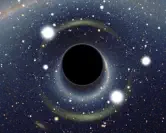
Artist’s impression of gas
around a black hole
Advertisement
Ligo - the Laser
Interferometer
Gravitational-Wave
Observatory
Older News Pages: 1
E = mc
2
& relativity in the news




















